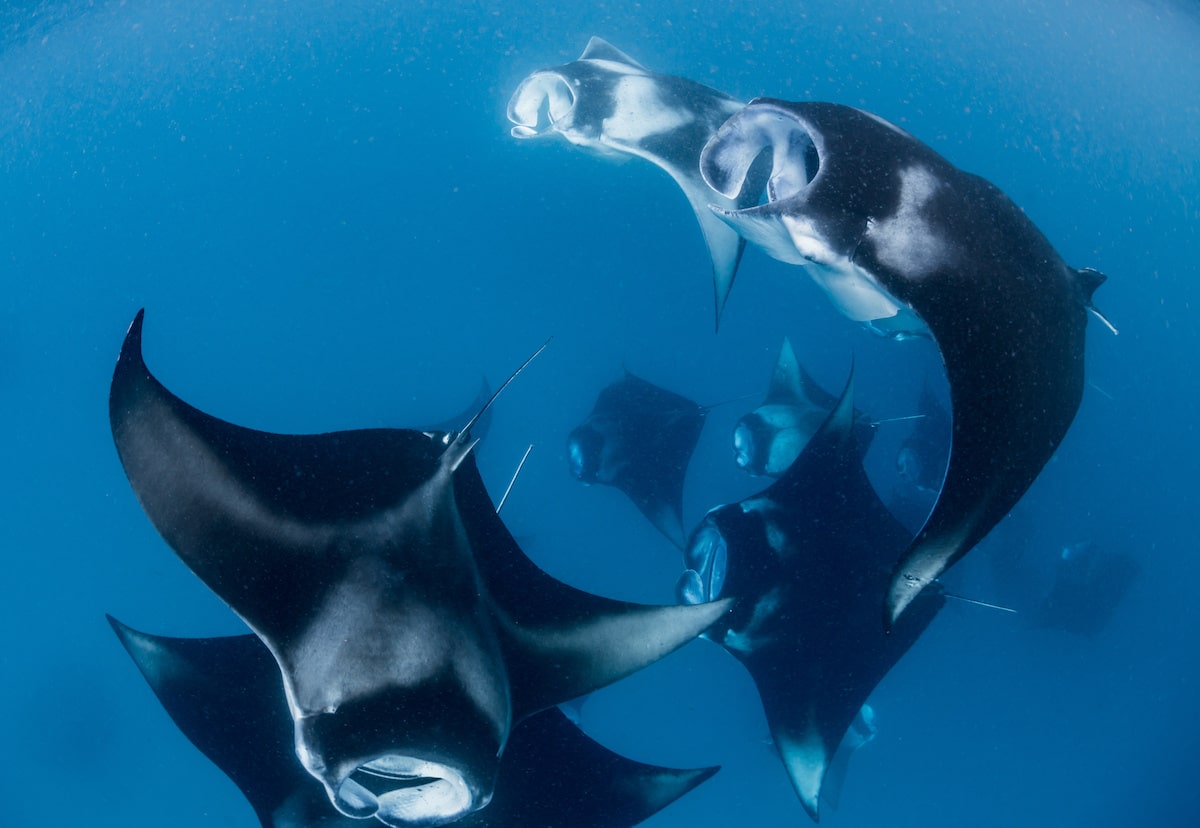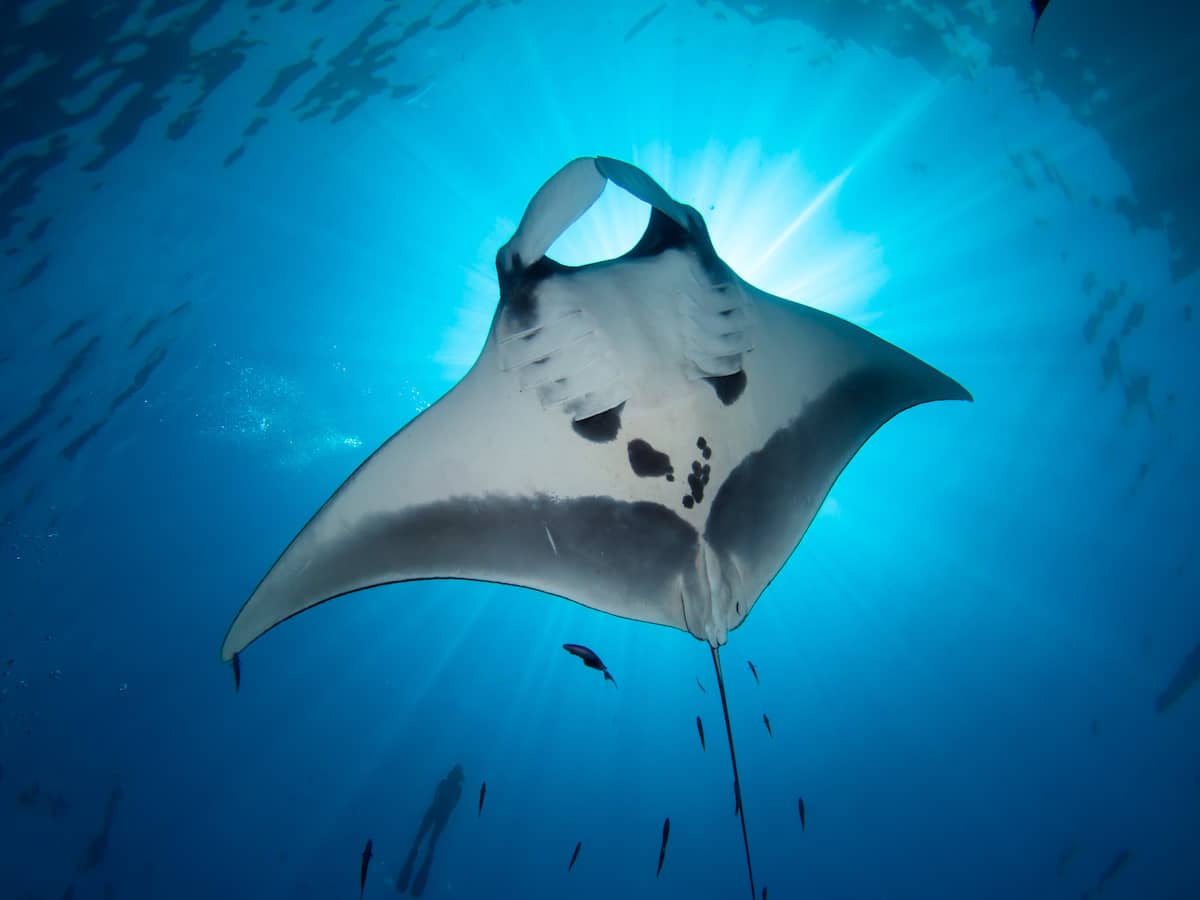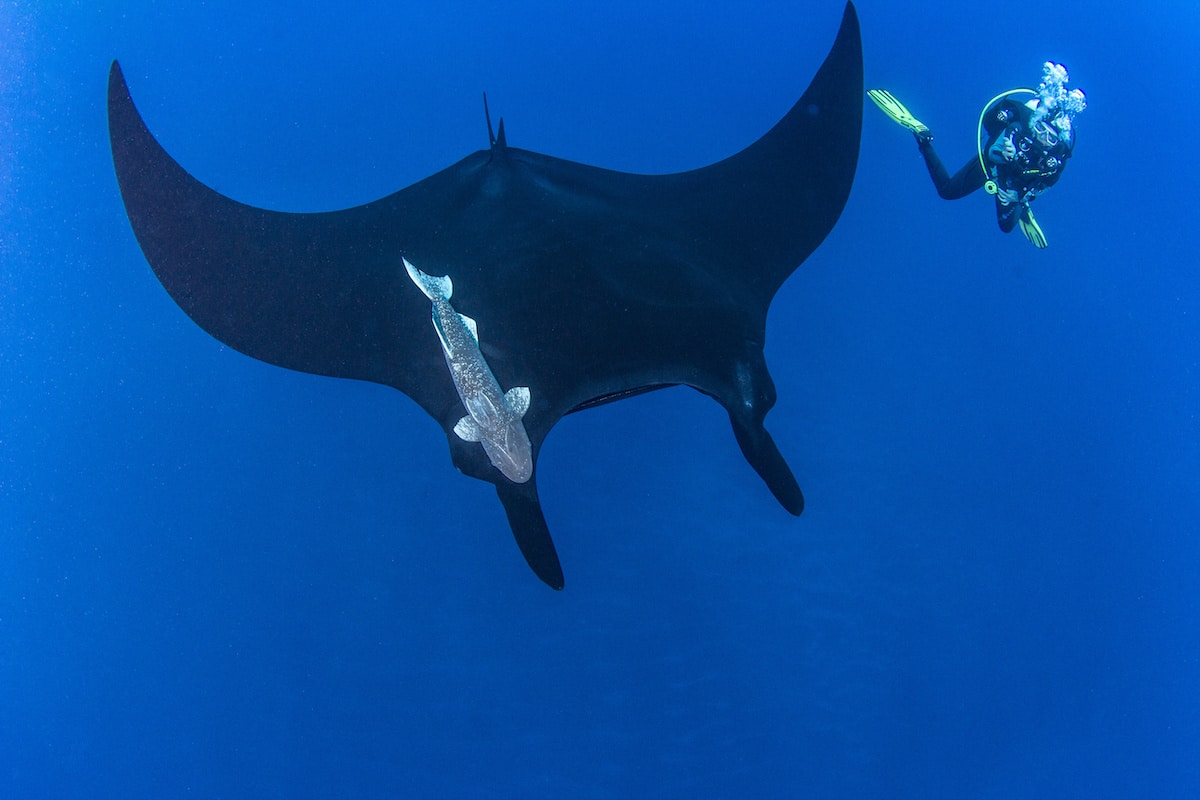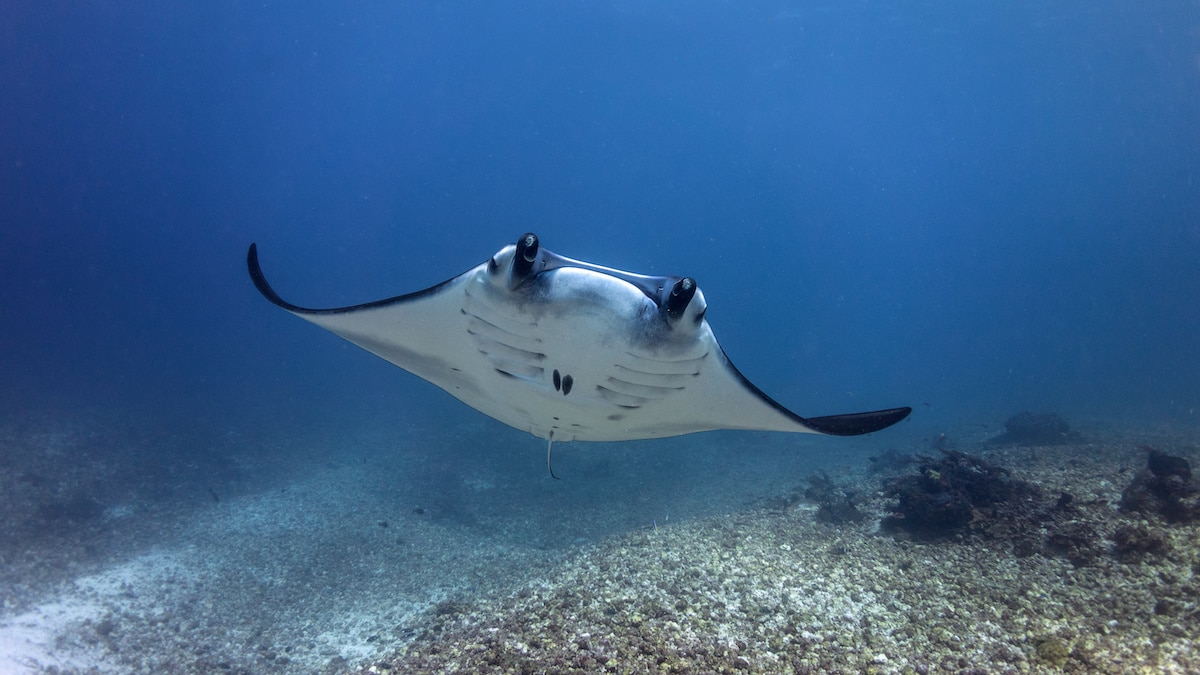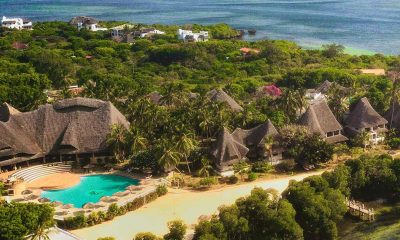News
16 Top Places to Dive with Manta Rays
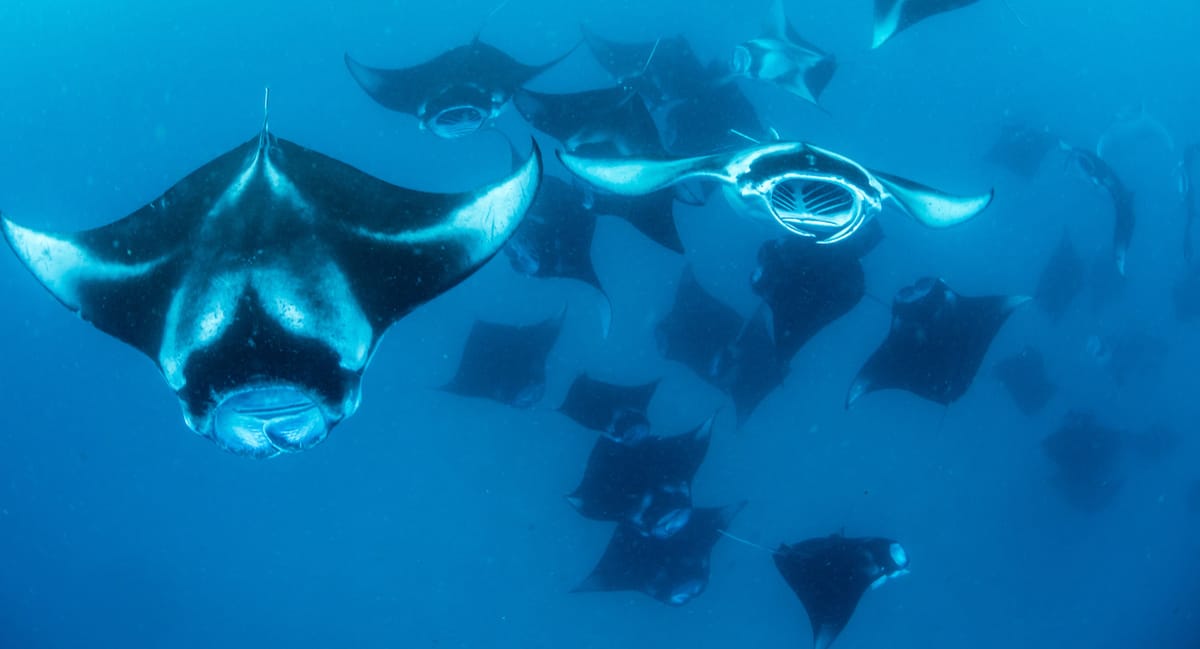
These is nothing quite as magical as spending time in the water with manta rays. These graceful creatures can be found at top dive destinations around the world and charm many divers every year. Read on for our top 16 liveaboard diving destinations where you can encounter these magnificent ocean giants.
Baa Atoll, Maldives
Baa Atoll is the place to go in the Maldives to swim with hundreds of feeding mantas. One of the Northern Atolls, Baa Atoll is famous for encounters with groups of mantas as they feed on seasonal plankton blooms in Hanifaru Bay.
The mantas funnel plankton within this small, enclosed bay in huge groups; swirling and barrel rolling as they feed. You can watch from your boat or go snorkelling with them.
When to go for mantas: May to November
Liveaboard: The Blue Voyager offers unique Manta Trust expeditions, during which you can swim with mantas and participate in research and conservation activities.
Rasdhoo Atoll, Maldives
Tiny Rasdhoo Atoll has just 4 islands and 3 sandbanks but there is plenty of marine life to find there. Manta Block is one of the best dive sites for spotting manta rays at their cleaning stations. You can also find mantas at Madifaru; a horseshoe-shaped reef teeming with diverse marine life.
Remember to leave time to go in search of hammerhead sharks at Hammerhead Point whilst you’re in the area.
When to go for mantas: November to April
Liveaboard: The Emperor Serenity offers Maldives safaris that include Rasdhoo Atoll and South Ari Atoll.
Southern Ari Atoll, Maldives
Ari Atoll is a classic Maldives dive destination made up of over 100 islands, with numerous submerged pinnacles busy with mantas. The most dependable dive sites for mantas are in southern Ari Atoll, with cleaning stations at Kudarah Thila and Rangali Madivaru.
When to go for mantas: January to April
Liveaboard: The Emperor Virgo offers Pelagic Magic safaris that focus on mantas and whale sharks in Ari Atoll.
Fiji
Fiji might be best-known for its exceptionally colourful coral reefs but there are abundant mantas to find there. The Yasawa Islands have mantas, including at Naviti Island’s coral-covered walls. For numerous mantas, Barefoot Island just south of the Yasawas is a popular choice.
You can also snorkel or dive with mantas at Kadavu, Namena Marine Reserve and Tavenui.
When to go for mantas: June to October
Liveaboard: The Nai’i offers small-group Fiji diving safaris and is one of the few liveaboards that operates there.
Kona, Hawaii
Another much-loved manta destination, Hawaii offers dramatic diving amidst lava landscapes and unique manta night dives. You can go night diving or snorkelling with mantas at Kona and this dive is regularly offered as part of liveaboard diving safaris.
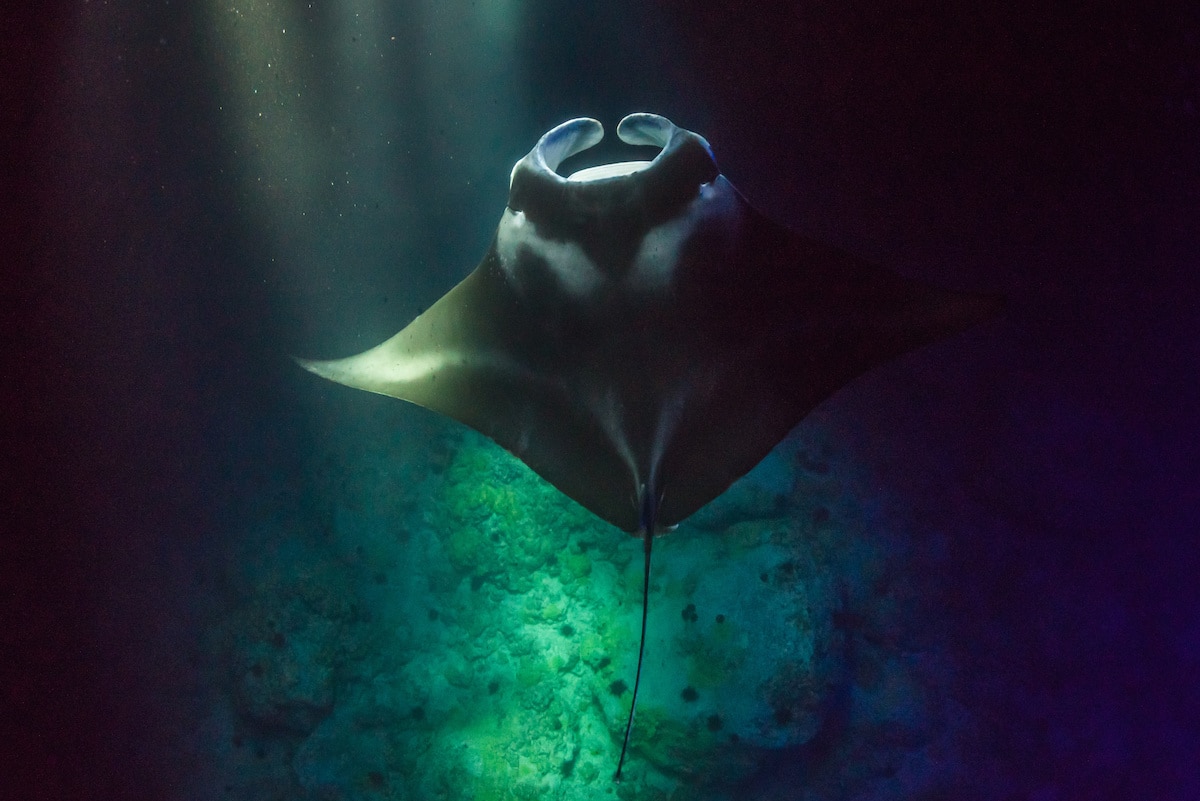
Take a good torch and your camera, then watch the mantas as they barrel-roll and feed in the light.
When to go for mantas: All year
Liveaboard: The Kona Aggressor II offers Hawaii dive safaris.
Socorro Islands, Mexico
If you want to go diving with huge oceanic mantas, you need to go diving at Mexico’s Socorro Islands. This remote destination can only be reached by liveaboard and offers the chance to dive with the world’s friendliest manta rays. These enormous mantas congregate at San Benedicto Island and use the cleaning stations found there.
Being tolerant of divers, they come close and offer fantastic photographic opportunities. Keep an eye out for bottlenose dolphins whilst you dive at Socorro – they are known for mimicking the mantas and divers movements.
When to go for mantas: November to May
Liveaboard: The Valentina offers 10-day Socorro Islands safaris.
Komodo, Indonesia
Indonesia is a great destination for manta ray encounters and Komodo is top of our list. Manta Alley has up to 50 mantas at any one time. You can also find them at Makassar reef, Batu Balong and Golden Passage.
Wherever you go in search of mantas in Komodo you’ll be surrounded by an abundance of other marine life; from tiny critters through to Mola mola, sharks, eagle rays and dolphins.
When to go for mantas: December or February for peak manta numbers.
Liveaboard: The Mikumba II offers barefoot luxury Komodo cruises and is a great option for food-lovers.
Raja Ampat, Indonesia
One of the best dive destinations in Indonesia (and the world), Raja Ampat doesn’t disappoint with its mantas. It is one of the only places in the world where you can see both reef and oceanic mantas.
Manta Ridge and Manta Sandy both host reef mantas, whilst Blue Magic is visited by oceanic manta rays. To see both species together, make sure you dive Magic Mountain.
When to go for mantas: December to March for peak manta numbers.
Liveaboard: The Kurabesi caters for just 12 guests and offers intimate Raja Ampat safaris.
Bali, Indonesia
For the chance to see both mantas and Mola mola, go scuba diving at Nusa Penida, Bali. This laid-back destination has numerous mantas all year, at sites such as Manta Bay and Manta Point.
You can also find Mola mola at Crystal Bay in Nusa Penida. As one of the few places in the world you can find these strange-looking fish, it is unmissable.
When to go for mantas: August to September to see both mantas and Mola mola.
Liveaboard: The Tiare offers cruises that include Nusa Penida.
Koh Bon, Thailand
Koh Bon and the Similan Islands are the jewels in the crown of Thailand’s Andaman diving scene. They are also great dive destinations for mantas.
Koh Bon has numerous mantas, reef sharks and good macro life. Meanwhile, the Similan Islands showcases some of Thailand’s best marine life – including manta rays at Boulder City and whale sharks.
When to go for mantas: Late February for manta rays and whale sharks at the Similan Islands.
Liveaboard: The Junk offers Andaman dive safaris to Koh Bon, the Similan Islands and the nearby Surin Islands.
Great Barrier Reef, Australia
You can see mantas throughout the Great Barrier Reef and they are known to cruise along the continental shelf at the Far Northern reefs.
Lady Elliot Island is also a well-known manta hotspot with hundreds of mantas. This special island is an easy addition to your Australian dive adventure.
When to go for mantas: May and June for peak manta numbers.
Liveaboard: The Spoilsport offers Far North Coral Sea Exploratory safaris.
Ningaloo Reef, Australia
Head to Australia’s northwestern coast and you can go diving off the Ningaloo Coast, a UNESCO-listed World Heritage area. There are plenty of whale sharks to be found at Ningaloo Reef, Australia’s largest fringing coral reef. Few people also realise Ningaloo Reef is busy with mantas, especially at Coral Bay.
When to go for mantas: May to October
Liveaboard: The Shore Thing catamaran offers small-group dive and snorkelling safaris at Ningaloo Reef.
Cabo Marshall, Galapagos
The Galapagos Islands feature at the top of many divers wish lists. Go Galapagos diving and you can see huge schools of hammerhead sharks, plus whale sharks, silky sharks, Galapagos sharks and more.
Did we mention the mantas? You can find plenty of giant mantas at the Galapagos Islands. Hotspots include the famed Wolf and Darwin Islands, Cousins Rock and Cabo Marshall. Cabo Marshall is visited by numerous mantas searching for food and cleaning stations. You can also spot mobula and cow-nose rays there.
When to go for mantas: December to May
Liveaboard: The Nortada liveaboard is ideal for exploring the Galapagos Islands without crowds of divers; catering to 12 guests maximum.
Palau, Micronesia
Palau is less well-known than other places for manta rays but it is one of the most reliable places for manta sightings. Palau’s German Channel has extremely swift currents but the dive site is at the southwest mouth and is one of the best dive sites for experiencing manta rays.
There are manta ray cleaning stations to enjoy and other marine life includes schools of blacktip reef sharks, grey reef sharks, barracuda and numerous tropical fish.
When to go for mantas: October to May
Liveaboard: The Solitude One offers budget-conscious Palau dive safaris.
Tuamotu Archipelago, French Polynesia
Rangiroa and Fakarava atolls are paradise; both above and below the water. These idyllic atolls attract an array of pelagics, including ‘walls of grey reef sharks’, humpback whales, dolphins and mantas.
Don’t miss them if you’re looking for a far-flung destination and peaceful diving.
When to go for mantas: August to October for mantas and humpbacks.
Liveaboard: The French Polynesia Master offers safaris to both Rangiroa and Fakarava.
Donsol, Philippines
Have you heard of Donsol yet? This Philippine dive area is known for its abundant whale sharks and lush volcanic landscapes. Manta Bowl is washed by plankton-rich waters that also attract manta rays to this aptly-named dive site. If you’re lucky, you might even see thresher or hammerhead sharks whilst diving there.
When to go for mantas: November to June for whale sharks and mantas.
Liveaboard: The luxurious Philippine Siren offers Malapascua and Donsol safaris. Just remember to book early as this is one of the most popular liveaboards out there.
This article was written by divers and writers at LiveAboard.com
Blogs
The Ocean Cleanup Breaks 10,000,000 KG Barrier

The Ocean Cleanup, the global non-profit project, has removed a verified all-time total of ten million kilograms (22 million lbs.) of trash from oceans and rivers around the world – approximately the same weight as the Eiffel Tower.
To complete its mission of ridding the oceans of plastic, The Ocean Cleanup uses a dual strategy: cleaning up the Great Pacific Garbage Patch (GPGP) to remove the plastic already afloat in the oceans, while stopping the flow of plastic from the world’s most polluting rivers.
Through cleaning operations in the GPGP and in rivers in eight countries, the cumulative total of trash removed has now surpassed ten million kilograms. This milestone demonstrates the acceleration of The Ocean Cleanup’s impact, while underlining the astonishing scale of the plastic pollution problem and the need for continued support and action.
While encouraging for the mission, this milestone is only a staging point: millions more tons of plastic still pollute our oceans and The Ocean Cleanup intends to continue learning, improving and innovating to solve this global catastrophe.
This announcement comes as governments from around the world meet to continue negotiations to develop a new legally binding instrument to end plastic pollution at INC4 in Ottawa, Canada. Representatives of The Ocean Cleanup will be in attendance and the organization will be urging decision-makers to collaborate towards a comprehensive and ambitious global treaty which addresses plastic at all stages of its life cycle and in all marine environments worldwide, including in areas beyond national jurisdiction.
It is encouraging to see that the need for remediation is reflected in the various options for potential treaty provisions. It is essential that the final treaty contains clear targets for the remediation of legacy plastic pollution, and reduction of riverine plastic emissions.
Tackling plastic pollution requires innovative and impactful solutions. The treaty should therefore incentivize the innovation ecosystem by fostering innovations that make maximal use of data, technology and scientific knowledge – such as those designed and deployed by The Ocean Cleanup.
‘After many tough years of trial and error, it’s amazing to see our work is starting to pay off – and I am proud of the team who has brought us to this point.’ said Boyan Slat, Founder and CEO of The Ocean Cleanup. ‘While we still have a long way to go, our recent successes fill us with renewed confidence that the oceans can be cleaned.’
The Ocean Cleanup was founded in 2013 and captured its first plastic in 2019, with the first confirmed catch in the GPGP coming soon after the deployment of Interceptor 001 in Jakarta, Indonesia. After surpassing one million kilograms of trash removed in early 2022, the non-profit project has since progressed to the third iteration of its GPGP cleaning solution, known as System 03, and a network of Interceptors currently covering rivers in eight countries, with more deployments set for 2024.
About The Ocean Cleanup
The Ocean Cleanup is an international non-profit organization that develops and scales technologies to rid the world’s oceans of plastic. They aim to achieve this goal through a dual strategy: stemming the inflow via rivers and cleaning up the legacy plastic that has already accumulated in the ocean. For the latter, The Ocean Cleanup develops large-scale systems to efficiently concentrate the plastic for periodic removal. This plastic is tracked and traced through DNV’s chain of custody model to certify claims of origin when recycling it into new products. To curb the tide via rivers, The Ocean Cleanup has developed Interceptor™ solutions to halt and extract riverine plastic before it reaches the ocean. Founded in 2013 by Boyan Slat, The Ocean Cleanup now employs a broadly multi-disciplined team of approximately 140. The foundation is headquartered in Rotterdam, the Netherlands.
For more information, visit: theoceancleanup.com and follow @theoceancleanup on social media.
Marine Life & Conservation
Steve Backshall to headline Shark Trust’s flagship event: For the Love of Sharks

Join a host of amazing, shark loving, speakers including Steve Backshall and the Shark Trust team for an evening celebrating shark conservation at the Royal Geographical Society in London this November.
Date: 29th November 2024
Time: 6-10pm
Location: Royal Geographical Society, London
Tickets: https://www.sharktrust.org/Event/flos24
The event will be a celebration of all things shark. Those lucky enough to get hold of tickets will hear from engaging guest speakers with a passion for sharks.
The line-up includes (*subject to change if unforeseen circumstances arise)
Steve Backshall: One of television’s busiest presenters, BAFTA award-winning wildlife expert Steve has been passionate about the wild world ever since he was young.
Steve’s impressive TV career has taken him all around the world, investigating a wide array of species and environments. Steve has filmed over 100 hours of children’s wildlife programmes with the BAFTA award winning Deadly 60 franchise and recently, with Sky Nature, for his new series ‘Whale with Steve Backshall’. He has been a patron for the Shark Trust for 10 years.
Simon Rogerson: is a photojournalist specialising in natural history, diving and the sea.
He is editor of SCUBA magazine, the official journal of the British Sub-Aqua Club. Simon started his career as a crime reporter but gravitated towards his ‘less depressing’ interest in underwater exploration, joining the staff of DIVE magazine in 1999. In 2005 he was named ‘Editor of the Year’ in the PPA’s Independent Publishing Awards. Simon also works as a freelance writer, contributing frequently to the Sunday Times and Telegraph, in addition to BBC Wildlife, Esquire, and a host of international diving magazines. He is the author of a book, Dive Red Sea, published by Ultimate Sports. Now based in Berkshire, Simon has been a Patron of the Shark Trust for 20 years.
More speakers to be announced soon. Head to the Shark Trust website to learn more.
The evening will also allow guests the final chance to see the Oceanic 31, shark art exhibition. Some of the artwork will be auctioned/raffled at the event, while the rest will be auctioned online to raise money for the Shark Trust Oceanic Programme.
For the Love of Sharks is an evening with something for everyone who is interested and fascinated by sharks. Join the Shark Trust, their Patrons, Trustees and Staff, along with a host of supporters for this celebration of shark conservation.
For more information or to buy a ticket: https://www.sharktrust.org/Event/flos24
-

 News3 months ago
News3 months agoCapturing Critters in Lembeh Underwater Photography Workshop 2024: Event Roundup
-

 Marine Life & Conservation Blogs3 months ago
Marine Life & Conservation Blogs3 months agoCreature Feature: Swell Sharks
-

 Blogs2 months ago
Blogs2 months agoMurex Resorts: Passport to Paradise!
-

 Blogs2 months ago
Blogs2 months agoDiver Discovering Whale Skeletons Beneath Ice Judged World’s Best Underwater Photograph
-

 Gear Reviews3 weeks ago
Gear Reviews3 weeks agoGEAR REVIEW – Revolutionising Diving Comfort: The Sharkskin T2 Chillproof Suit
-

 Gear Reviews3 months ago
Gear Reviews3 months agoGear Review: Oceanic+ Dive Housing for iPhone
-

 Marine Life & Conservation2 months ago
Marine Life & Conservation2 months agoSave the Manatee Club launches brand new webcams at Silver Springs State Park, Florida
-

 News2 months ago
News2 months agoPADI Teams Up with Wellness Brand Neuro to Drive Ocean Change and Create a Blue State of Mind


